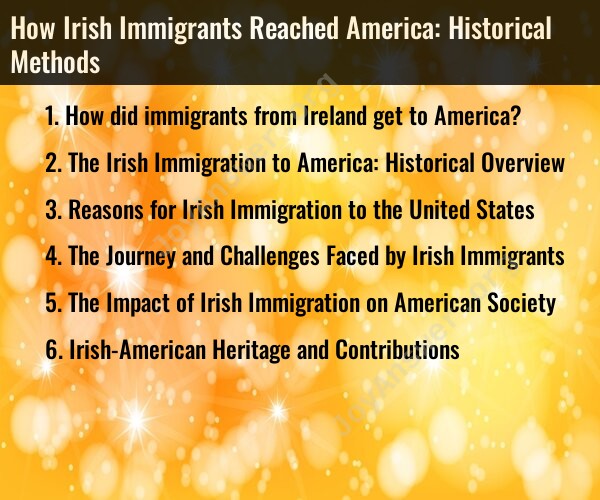How did immigrants from Ireland get to America?
Irish immigration to America occurred over several centuries, with different waves of immigrants arriving under varying circumstances. Here are some historical methods and key periods through which Irish immigrants reached America:
Colonial Era (1600s-1700s): During the colonial period, Irish immigrants, often as indentured servants or convicts, were among the early settlers in the American colonies. Many came as part of the British colonial system. They arrived by ship, mainly from Ireland, England, and Scotland.
Great Famine (1840s-1850s): The most significant wave of Irish immigration to the United States occurred during and after the Great Famine (also known as the Great Potato Famine or the Irish Potato Famine) in Ireland. This period saw a mass exodus of Irish people due to crop failures, famine, and economic hardship. Many Irish immigrants arrived in the United States on overcrowded "coffin ships," which were often unseaworthy vessels. These ships carried immigrants across the Atlantic, with many arriving at ports on the eastern seaboard of the United States, such as New York, Boston, and Philadelphia.
Post-Famine Immigration (Late 1800s): After the Great Famine, Irish immigration to the United States continued, albeit at a slower pace. Many Irish immigrants came to escape poverty, seek better economic opportunities, or join family members who had already settled in America. The transatlantic journey was still typically made by ship.
Urbanization and Labor: Irish immigrants played a significant role in building American infrastructure, particularly in the construction of canals, roads, and railroads. They were also involved in various forms of labor, including mining, factory work, and domestic service.
Migration to Cities: Irish immigrants settled in cities and urban areas, often forming tight-knit communities. Cities like New York, Boston, Philadelphia, and Chicago had substantial Irish populations. They often faced discrimination and prejudice but also made significant contributions to American culture and society.
Steamships: As technology advanced, the method of crossing the Atlantic evolved. Steamships gradually replaced sailing vessels, making the journey more efficient and comfortable. This facilitated further immigration.
Ellis Island: In the late 19th and early 20th centuries, Ellis Island in New York Harbor became a significant immigrant processing station. Millions of immigrants, including many Irish, passed through Ellis Island. Immigration officials screened and documented newcomers, and some individuals were detained or deported based on health or legal grounds.
It's important to note that Irish immigration to the United States was influenced by historical events, social and economic conditions, and American immigration policies. The Irish diaspora in America contributed to the country's cultural, political, and economic development, with Irish-Americans making notable contributions in various fields.
The Irish Immigration to America: Historical Overview
Irish immigration to the United States was a significant demographic shift that occurred over several periods, with the largest waves occurring during the mid-19th century. The Potato Famine of 1845-1852 was a major catalyst for this mass exodus, as millions of Irish people were forced to leave their homeland due to starvation and disease. Between 1840 and 1920, an estimated 4.5 million Irish people immigrated to the United States, seeking a better life and escaping the harsh realities of their homeland.
Reasons for Irish Immigration to the United States
Several factors contributed to the large-scale Irish immigration to the United States:
The Potato Famine: The catastrophic Potato Famine, caused by a potato blight that destroyed the staple crop of Ireland, led to widespread hunger, death, and desperation. This devastating event prompted many Irish people to seek opportunities and survival elsewhere.
Economic Hardship: Ireland faced economic hardship and a lack of employment opportunities during the 19th century. Land ownership was concentrated in the hands of a few, leaving many Irish people with limited prospects for economic advancement.
Political and Religious Persecution: Many Irish Catholics faced discrimination and persecution under British rule. They sought religious freedom and political equality in the United States.
The Promise of a Better Life: The United States represented a land of opportunity and hope for many Irish immigrants. They were drawn by the promise of jobs, land ownership, and a better future for themselves and their families.
The Journey and Challenges Faced by Irish Immigrants
The journey to America was arduous and often perilous for Irish immigrants. They traveled in overcrowded and unsanitary conditions, facing the risks of disease, malnutrition, and even death during the long sea voyage.
Upon arrival in the United States, Irish immigrants faced numerous challenges:
Discrimination: They were often subjected to prejudice and discrimination due to their ethnicity and religion.
Poverty: Many Irish immigrants found themselves trapped in poverty, working in low-paying jobs and living in overcrowded tenements.
Urbanization: They were drawn to cities, where they often faced crowded living conditions, poor sanitation, and high crime rates.
Despite these challenges, Irish immigrants demonstrated remarkable resilience and determination. They worked hard, established communities, and contributed significantly to American society.
The Impact of Irish Immigration on American Society
Irish immigration had a profound impact on American society:
Labor Force: Irish immigrants played a crucial role in building and expanding America's infrastructure, working in industries such as construction, transportation, and mining.
Culture: Irish immigrants brought their rich cultural traditions to the United States, influencing music, dance, literature, and cuisine.
Politics: Irish immigrants became active in American politics, gaining representation in local, state, and federal governments.
Catholicism: The influx of Irish Catholics contributed to the growth of Catholicism in the United States, influencing the religious landscape of the country.
Irish-American Heritage and Contributions
Irish-Americans have made significant contributions to American society in various fields, including:
Politics: Numerous Irish-Americans have served in high-ranking political positions, including presidents, senators, and governors.
Literature: Irish-American writers have enriched American literature with their works, including John F. Kennedy, Eugene O'Neill, and Edna St. Vincent Millay.
Music: Irish-American musicians have played a vital role in shaping American music, particularly in genres like jazz, country, and rock and roll.
Sports: Irish-Americans have excelled in various sports, including boxing, baseball, and basketball.
Irish-American heritage continues to be celebrated and honored in the United States, with events such as St. Patrick's Day parades and festivals showcasing the rich cultural traditions passed down through generations.












